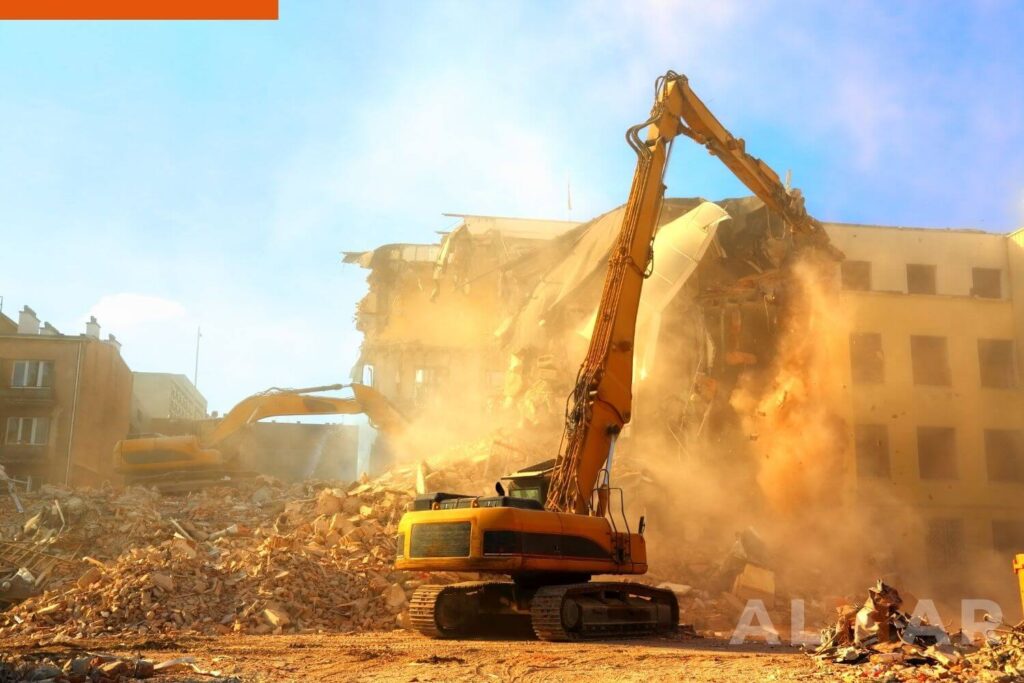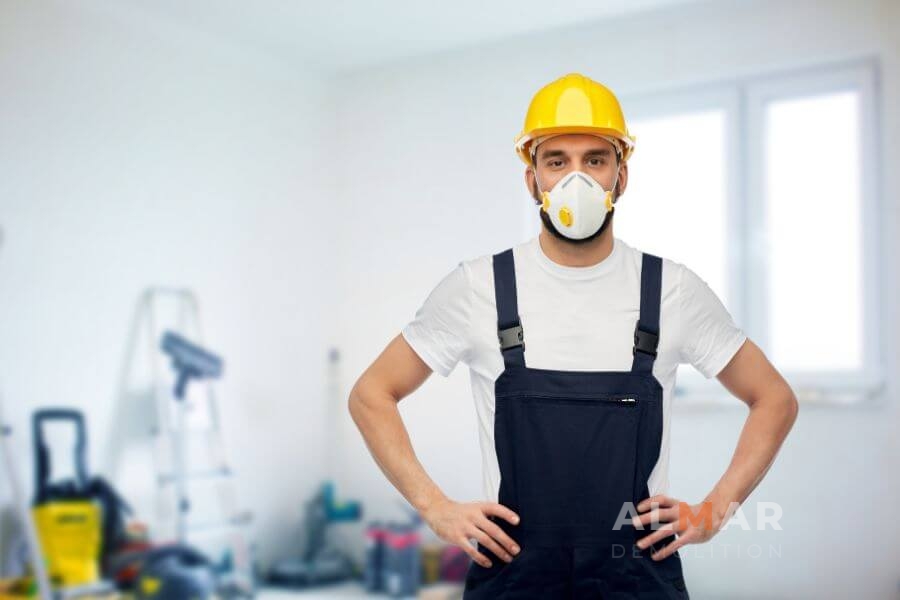Dust in demolition can pose a variety of hazards affecting both worker health and the environment. It is essential to understand these hazards for effective dust control. Some of the potential health risks associated with dust exposure during demolition include respiratory issues, eye irritation, and skin irritation.
Environmental concerns associated with dust in demolition include soil and water contamination, vegetation damage, and air pollution. Regulatory frameworks are in place to control dust emissions during demolition, with strict fines for non-compliance.
Exposure to hazardous materials such as asbestos and lead presents long-term health risks, thus requiring specialized management. In addition, dust can also create combustible dust hazards, increasing the risk of fire and explosion.
In this article, we will provide you with essential strategies to implement dust control and ensure a healthy work environment.
1. Conduct a Thorough Risk Assessment
Before starting any demolition project, it’s essential to conduct a comprehensive risk assessment to identify potential sources of dust, assess exposure risks, and determine suitable control measures. A thorough understanding of the site’s conditions, materials, and processes is critical to selecting the appropriate dust control strategies.
The risk assessment process should involve:
-
- Site inspection: Assessing the site’s condition, layout, and materials to identify potential sources of dust emissions.
- Process review: Evaluating the demolition process to determine which activities are likely to generate dust and the extent of airborne dust emissions likely to occur.
- Risk identification: Identifying the potential hazard associated with the dust, the likely exposure routes, and levels of exposure that may occur.
- Assessment of control measures: Considering the suitability of different control measures for reducing dust, including engineering controls, administrative controls, and personal protective equipment (PPE).
- Determination of control measures: Selecting control measures based on their effectiveness, feasibility, and costs.

2. Implementing Engineering Controls
Engineering controls are crucial in reducing dust levels during demolition and construction activities. By implementing effective engineering controls, workers can minimize their exposure to hazardous dust and maintain a healthy work environment. Below are some techniques to suppress dust at its source.
Wetting
Wetting the work area is a simple yet effective dust suppression technique. Water spray systems can be used to wet surfaces and reduce dust creation during demolition. Wetting agents can be added to water to improve surface coverage and make the water more effective at controlling dust.
Encapsulation
Encapsulation involves coating surfaces with a layer of sealant to prevent dust from becoming airborne. This technique works best for areas with friable materials like asbestos. The sealant essentially encapsulates the material and prevents it from releasing hazardous dust during demolition.
Local Exhaust Ventilation
Local exhaust ventilation involves using exhaust fans to capture and remove dust at the source. The captured dust is then transported through ductwork and collected in a dust collector. This technique is effective for capturing dust generated from cutting, sawing, and grinding activities, among others.
3. Personal Protective Equipment (PPE) for Dust Control
Personal Protective Equipment (PPE) is an essential component of dust control during demolition activities. It can help safeguard workers from the potential dangers of dust exposure and minimize the risk of respiratory and other health complications. Here are some types of PPE you may consider:
- Dust masks: Designed to filter out particulate matter from the air. They must fit properly to maximize protection, and should be changed regularly to maintain efficacy.
- Respirators: Provide respiratory protection against dust and other air contaminants. They must be selected based on the specific hazards present and suitably fit tested to ensure optimal performance.
- Coveralls and gloves: Can protect workers from dust exposure and other contaminants that may come into contact with skin. Disposable options may offer a higher level of protection and should be used when necessary.
Eye and ear protection: Eye goggles and earplugs can protect from dust entering the eyes and ears, respectively. They should be used whenever appropriate to minimize risk of injury.
4. Safe Work Practices
Implementing safe work practices is essential for minimizing dust dispersion during a demolition. By adopting the following guidelines, you can maintain a clean and healthy work environment:

Proper Waste Handling
Ensure that all waste, including debris and materials, is properly contained and disposed of. Use wheeled containers with lids, and avoid spreading waste over a large area. Establish designated waste management areas, and prohibit smoking in these areas to prevent fire hazards.
Containment Measures
Containment measures can effectively reduce dust levels during demolition. Use plastic sheeting or other barriers to contain dust in specific areas, and ensure that these barriers are secure and sealed. Cover floors and other surfaces with plastic sheeting to simplify cleaning and reduce dust buildup.
Site Cleanup Procedures
Implement effective cleaning procedures throughout the demolition project. Use wet methods whenever possible to suppress dust, and avoid dry sweeping or using compressed air to clean surfaces. Conduct regular inspections to identify areas that require cleaning, and ensure that all equipment is well-maintained and regularly cleaned.
By implementing safe work practices, you can minimize dust levels, protect worker health, and comply with regulatory requirements.
5. Training and Education
Providing proper training and education to workers is essential for a successful dust control program. It’s crucial to raise awareness about the hazards of dust exposure and educate workers on effective control measures and safe work practices.
6. Monitoring and Air Quality Testing
To ensure the effectiveness of dust control measures, regular monitoring and air quality testing are crucial. Dust monitoring should be conducted frequently to record dust levels and evaluate the efficiency of control measures. Air quality assessments are also essential to confirm compliance with regulations and ensure a safe working environment.
Dust monitoring involves the use of specialized equipment to measure dust levels at the demolition site. The data collected can help identify areas where dust levels exceed recommended limits and determine the effectiveness of control measures. Regular monitoring also enables early detection of any potential issues, allowing prompt action to be taken.
Air quality assessments involve the sampling and analysis of air samples to determine the concentration of airborne pollutants emitted during demolition. Results from air quality tests help assess compliance with regulatory limits and provide insights into the overall air quality within the vicinity of the site.
Overall, managing dust and its associated risks is paramount. Almar Demolition Company recognizes the potential challenges posed by dust exposure and prioritizes the implementation of robust dust control measures to create a safe and healthy work environment. Staying current with industry best practices and a continuous improvement mindset are integral to our approach. At Almar Demolition, we not only prioritize regulatory compliance but also the well-being of our workers, striving for excellence in every demolition project we undertake.
For more information or to request a free, detailed quote, contact ALMAR Demolition at (647) 575-5085.